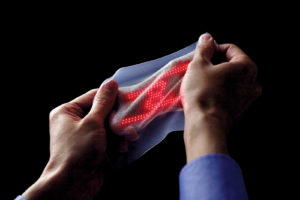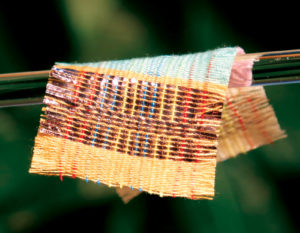
IoClothes describes itself as “A Community Fusing Tech & Textiles™” that exists to support those who innovate in the smart textile industry by providing information and helping them to establish the right connections to move forward. Managing director Ben Cooper says, “About 30–40 percent of the [textile] industry has a warm-to-hot interest in innovation—new processes, new materials to differentiate, new ways to offer value propositions to their customers. They span a very wide range—manufacturers, brands, materials suppliers—the full eco system.” Another 20 percent he describes as “moderately interested.”
That may seem as a good number of interested businesses, but in B2B relationships, “There aren’t very many true early adopters,” Cooper says. Using a broad interpretation, however, “Early adopters are those that are thinking differently, see some indications of the market changing, but have the means to invest in it,” he says. Among the early adopters, most are cautious. “There’s a tendency to hesitate from taking that next step, to seriously build it into a product plan.”
Stephanie Rodgers, director of product research and development for New York-based Apex Mills Inc., says the real early adopters are the research teams and collaborators. “This is where the growth is happening. They have a personal interest, a newness to textiles—the hybridization to combine and create has opened the minds of many in the research world,” she says. “Every major university now has something—textile design, just a knitting machine, something.”
“Early adopters play a critical role, [but they’re] underutilized and not used as effectively as they might be,” says Qaizar Hassonjee, president of Hass Tech Associates LLC, Chadds Ford, Pa. One way to use early adopters better is to enlist their help in launching new “user experiences.” If early adopters do the beta testing on a product, it can help save both time and money.
“The early adopters are the ones who will say, ‘I like it, or I want it different,’” he says. “They become a part of your beta testing because you can learn from it very quickly. No matter how much you do in-house, once you bring the product out you have new learning, and that new learning is critical in how it will perform in a 1.1 generation, if not a 2.0 generation.”
In fact, he says, this beta testing is more significant than in-house testing. “It’s the instant feedback. Then you can make the experience even better much faster, and as it gets more commercialized, the consumer has a better experience … Even if I’m not selling to the consumer, I have to think about my customer selling to the consumer,” Hassonjee says.
Growing textile technologies
Certain technologies appear to be poised for significant growth. Rodgers puts e-textiles close to the top of that list. Adopters in fashion are most obvious, and some textiles with sensing or thermal control will have an impact. But where the tech is really going to go, she says, is the combination of fiber optic yarn systems with textiles.
“Fiber optics are fairly rigid now, but advanced research work is crashing the fiber optic world with the yarn world right now and trying to create flexible communication in yarn.” She points specifically to work underway with Advanced Functional Fabrics of America (AFFOA) at MIT.
“It’s my belief that smart textiles will bust open this industry in a way that very few can even imagine … The Internet of Things is real,” Cooper says, creating the possibility of whole new economies, with textiles adding “incredible value” to everyone’s lives. “It’s inconceivable that it won’t happen. … The problem is that we rely on six smart people who sit in a room to come up with ideas for millions of people. That’s absolutely backward. When you have people build on each other’s work, we create economies on top of these products. That’s how you create value.”
Rodgers predicts the biggest growth spurt in textiles will be in composites. “There’s a good market now, but I think the polymer chemistry has changed and more traditional textiles will be placed into resin systems and allow that resin system to perform better than it would without it,” she says. “In the early stage in composites, the resin did most of the work, but more functional systems—resin and textile systems together—can be thinner and be shaped into more form factors. Textiles allow this.”
Cooper also cites manufacturing process developments as one of the exciting things happening in the textile industry today. “Companies are making really significant changes, which will make more advanced textiles possible: 3-D modeling, 3-D scanning of materials, transferring into new cutting processes, optimizing processes and getting ahead of system malfunctions—these are incredibly important because you have to become more efficient,” he says.
There are many more functionalities and market areas that Rodgers expects to be affected by new textile technologies. “Photovoltaics, safety, infrastructure—there are going to be places where we’re covering fabric that we haven’t been,” she says. Cinder block could contain textiles, and high-performance communicating yarn could signal the lights to turn on or off.
Imagine if Puerto Rico, for example, had tarps that combined photovoltaics not only to cover a roof temporarily, but to provide power that could be used house-to-house, at least temporarily. The U.S. Army, she notes, already has similar applications, and some of its technology, including photovoltaics, “is out on the street.”
Hassonjee is looking at new markets for smart textiles, such as in senior living. Because seniors are so familiar and comfortable with textiles, he says it makes sense to be looking at this market for products that support “aging in place.”
“Moving has a psychological impact, and a financial impact that’s huge. To extend independent living for a year or even six months is significant, and the quality of life is better,” he says. It’s also a market with a future. “Every day there are 10,000 new seniors, and that will continue for the next 25 years.”
One of the tech developments that will literally power innovation in smart textile development is 5G (fifth-generation wireless communication), which Cooper says will reduce power consumption down to a fraction of what is used now. “Power issues won’t really be there; the requirements for hardware will not really be there. Investment in these things will not be required. Where we get our revenue is from services we build on top of it.”
Needed now
“What I don’t want to happen in e-textiles is that they just blow themselves out,” Rodgers says. But marketing for them is “very complex,” and standards for e-textiles, which she is involved in developing, are important. “Everybody just can’t do their own thing,” she says.
In textiles there are so many steps, Rodgers says: “It’s an exhaustively painful process.” Having textile developing centers, such as AFFOA, where people can go and get help, is a great idea and will help
to “soften some of the IP [intellectual property] frustration” generated by confidentiality concerns.
For small companies it’s often the need for investors, and connecting the two is “not very efficient,” Hassonjee says. “What’s needed is a faster time frame at a lower cost. Early adopters can help, though, because you can demonstrate success with them and improve your chances. You take the risks, but you get rewarded if it works. After all that in-house testing, there is still that unknown. That’s where the early adopters come in. My philosophy is to do that earlier and faster.”
Cooper also sees the need for more access to capital. A normal R&D budget in a textiles product company doesn’t compare to that of a tech company, he says. “We’re in an extremely commoditized market, generally. But if we rethink our business model and how we offer value to our customers, we realize that we have the opportunity to create platforms. That’s an important distinction. When an article of clothing becomes a platform, it’s a whole new game.”
And he’s starting to see the shift. A shirt can give the wearer his or her heart rate, but an open system allows people to create something more with this. “Like the Apple app store,” he says. “Who doesn’t rely on the app store to customize their phone? Everybody does that. Imagine if your jacket or your shirt did that.
“I see smart textiles as a general sort of technology. Automotive, home textiles … I don’t look at that as different from medical or fitness. I see it as continuous …When somebody says, ‘We’re going to play the long game on this; it is an incredible opportunity,’ we’ll create systems that people will not say no to. This is what creates a new business that cannot fail.”
Janet Preus is senior editor of Advanced Textiles Source and a regular contributor to Specialty Fabrics Review.
 TEXTILES.ORG
TEXTILES.ORG



